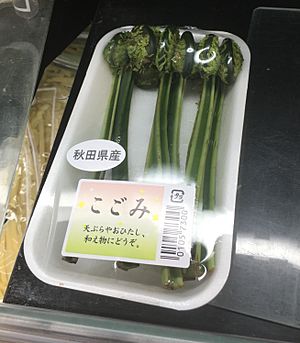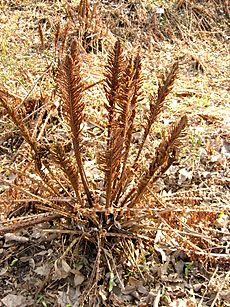Matteuccia facts for kids
Quick facts for kids Matteuccia |
|
|---|---|
 |
|
| Ostrich fern in Rouge National Urban Park (Ontario, Canada). | |
| Scientific classification | |
| Genus: |
Matteuccia
|
| Species: |
struthiopteris
|
| Synonyms | |
|
List of synonyms
Matteuccia pensylvanica (Willd.) Raymond
Matteuccia pennsylvanica (Willd.) Raymond (common misspelling) Onoclea struthiopteris L. Pteretis nodulosa Matteuccia nodulosa Fernald Matteuccia struthiopteris subsp. pensylvanica (Willd.) Á. Löve & D. Löve Onoclea pensylvanica (Willd.) Sm. Pteretis pensylvanica (Willd.) Fernald Pteretis struthiopteris var. pensylvanica (Willd.) Farw. Struthiopteris nodulosa Desv. Struthiopteris pensylvanica Willd. Struthiopteris filicastrum All. Pteris sinuata Thunb. |
|
Matteuccia is a type of fern with only one main species: Matteuccia struthiopteris. This fern is known by several common names, like ostrich fern, fiddlehead fern, or shuttlecock fern. Its scientific name, struthiopteris, comes from ancient Greek words meaning "ostrich" and "fern". This name describes how the fern's leaves look, much like an ostrich's feathers.
Contents
What Does the Ostrich Fern Look Like?
The ostrich fern has two different kinds of leaves, called fronds. The green fronds are the ones you usually see. They can grow very tall, about 100 to 170 centimeters (40 to 67 inches) high. These fronds are wide at the bottom and get narrower towards the top. This shape makes them look a lot like the feathers of an ostrich, which is how the fern got its name. These green fronds fall off in the autumn.
The other type of frond is shorter, about 40 to 65 centimeters (16 to 26 inches) long. These are the fertile fronds, which means they carry the fern's spores. They turn brown when they are ready. These special fronds stay upright through the winter. In early spring, they release their spores, which are like tiny seeds that help the fern reproduce. The ostrich fern is one of the largest ferns found in eastern North America.
How Ostrich Ferns Are Classified
Matteuccia struthiopteris is the only species in its group, called the genus Matteuccia. Scientists used to think two other Asian fern species belonged to this group. However, new studies of their DNA show that Matteuccia struthiopteris is actually more closely related to other ferns like the sensitive fern. Because of this, the two Asian species have been moved to a different genus.
The ostrich fern was once placed in a larger fern family. But now, it has been moved to a new, smaller family called Onocleaceae. This change happened as scientists learned more about how ferns are related to each other.
Where Ostrich Ferns Grow
The ostrich fern grows in cool, mild parts of the world. You can find it in central and northern Europe, northern Asia, and northern North America. It grows from a central point, forming a "crown." It likes to grow near rivers and on sandbars.
This fern also sends out side shoots, called stolons. These stolons grow underground and then pop up to form new fern plants. This means that ostrich ferns can create thick groups or "colonies." These colonies are very strong and can even survive floods.
Growing and Using Ostrich Ferns
The ostrich fern is a popular plant for gardens because it looks so nice. It has even won an award for being a great garden plant. If you plant it, remember that it can spread out a lot. Also, its leaves might not look as good later in the summer, especially if they are hit by strong winds or hail.
Fiddleheads as Food

The young, tightly curled fronds of the ostrich fern are called fiddleheads. They are picked and cooked as a vegetable. Many people in rural areas of northeastern North America think they are a special treat. It is important to know that you should never eat fiddleheads uncooked. Always cook them first. Also, the brown, papery bits on the fiddleheads are not edible and should be scraped or rinsed off before cooking.
Fiddleheads are also gathered and eaten all over Japan, where they are known as "kogomi." They are considered a delicacy there too. Some insect larvae also eat Matteuccia species as part of their diet.
See also
 In Spanish: Matteuccia struthiopteris para niños
In Spanish: Matteuccia struthiopteris para niños


